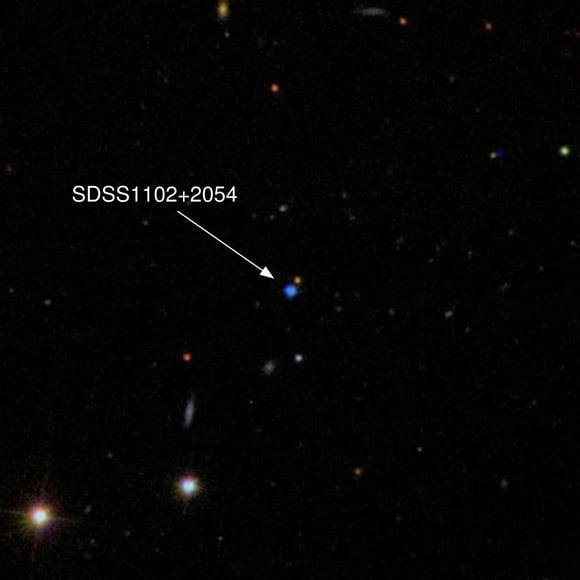White dwarfs are strange stars, but researchers recently discovered two of the strangest yet. However, these two oddballs are a missing link of sorts, between massive stars that end their lives as supernovae and small to medium sized stars that become white dwarfs. Somehow, these two once-massive stars avoided the core collapse of a supernova, and are the only two white dwarfs known to have oxygen-rich atmospheres. These so-called massive white dwarfs have been predicted, but never before observed.
The stars, named SDSS 0922+2928 and SDSS 1102+2054 are 400 and 220 light years from Earth. They are both remnants of massive stars that are at the end of their stellar evolution having consumed all the material they had available for nuclear fusion.
The low levels of carbon visible in their spectra indicate the stars have shed part of their outer layers and burned the carbon contained in their cores.
"These surface abundances of oxygen imply that these are white dwarfs displaying their bare oxygen-neon cores, and that they may have descended from the most massive progenitors stars in that class," said astrophysicist Dr. Boris Gänsicke from the University of Warwick, lead author on a paper appearing in this week's edition of Science Express.
[caption id="attachment_44852" align="aligncenter" width="400" caption="Dr. Boris Gänsicke from the department of physics at the University of Warwick."]
[/caption] Gänsicke told Universe Today that he and his team didn't start out specifically looking for these previously theoretical stars. "I've been working with our research student Jonathan Girven on several projects on white dwarfs, and we came across a range of unusual looking objects -- some we are still puzzling what they are. From a theoretical perspective, I was wondering if white dwarfs with oxygen-rich atmospheres exist, and combining both angles, we developed a specific search for these stars."
In a search of Sloan Digital Sky Survey data, the astrophysicists did indeed discover two white dwarfs with large atmospheric oxygen abundances.
Almost all white dwarfs have hydrogen and/or helium envelopes that, while low in mass, are sufficiently thick to shield the core from direct view. Theoretical models predicted that if stars around 7 – 10 times the mass of our own Sun don't end their lives as supernovae, the other option is that they will consume all of their hydrogen, helium and carbon, and end their lives as white dwarfs with very oxygen-rich cores.
Astrophysicists could then detect an extremely oxygen-rich spectrum from the surface of the white dwarf. Most stellar models producing white dwarfs with such oxygen and neon cores also predict that a sufficiently thick carbon-rich layer should surround the core and avoid upward diffusion of large amounts of oxygen.
However, calculations also show that the thickness of this layer decreases the closer the progenitor star is to upper mass limit for stars ending their lives as white dwarfs. Hence one possibility for the formation of SDSS 0922+2928 and SDSS 1102+2054 is that they descended from the most massive stars avoiding core-collapse, in which case they would be expected to be very massive themselves. However current data is insufficient to provide any unambiguous measure of the masses of these two unusual stars.
What is the future for these massive white dwarfs? Gänsicke said the two stars will evolve very slowly. "Given that they are burnt-out stellar cores that do no longer undergo nuclear fusion, their destiny is to continue cooling and fading. This will be a very slow process, and any noticeable change in their appearance will take 10s to 100s million years."
Lead image caption: Sloan Digital Sky Survey spectroscopy of this inconspicuous blue object -- SDSS1102+2054 -- reveals it to be an extremely rare stellar remnant: a white dwarf with an oxygen-rich atmosphere
Sources:
Science
, email interview with Gänsicke
 Universe Today
Universe Today
